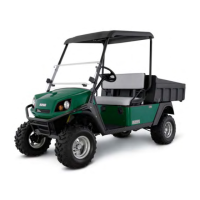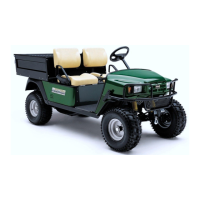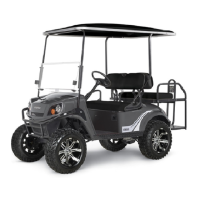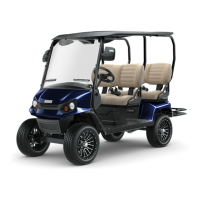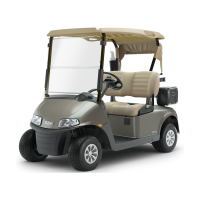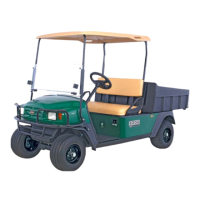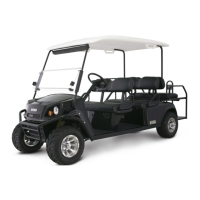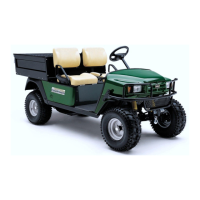Do you have a question about the Ezgo TERRAIN 250 and is the answer not in the manual?
Defines safety symbols and provides general safety advice for vehicle operation and maintenance.
Explains safety notices, cautions, warnings, dangers, and pre-servicing safety precautions.
Details safety warnings for fuel, batteries, and awareness of carbon monoxide hazards.
Covers battery removal/installation safety and critical procedures for lifting the vehicle.
Provides detailed instructions and safety precautions for lifting the vehicle securely.
Outlines the recommended schedule for regular vehicle maintenance tasks.
Provides instructions for conducting a road test to verify speed control system performance.
Covers powertrain maintenance and the procedure for checking engine oil level.
Details the process for changing engine oil and cleaning the engine exterior.
Provides engine specifications and the procedure for compression measurement.
Covers rocker cover removal, valve clearance inspection, and adjustment.
Covers engine installation and drive clutch removal procedures.
Provides the step-by-step process for removing the drive clutch.
Details the procedure for removing the drive clutch assembly.
Provides resistance testing procedures for the magneto.
Details procedures for testing the starting and charging circuits of the vehicle.
Details repair/replacement procedures for starter/generator and battery voltage testing.
Covers battery testing, DVOM usage, and general troubleshooting for electrical issues.
Covers checking battery condition, wires, and fuses within the electrical system.
A table listing common brake system issues, possible causes, and corrections.
Covers inspection of the brake pedal, linkage, and free travel.
Covers checking pedal free travel, clevis pins, equalizer linkage, compensator, and parking brake hinge.
Outlines the procedure for performing a periodic brake performance test.
Details the procedure for conducting an aggressive stop test for brake evaluation.
Provides procedures for inspecting wheel brake components.
Procedure for checking and adjusting the brake pedal's free travel.
Covers disassembly, cleaning, inspection, and re-assembly of wheel brake assemblies.
Details the procedure for replacing brake shoes and adjuster components.
Details the procedure for checking and adjusting the brake pedal's free travel.
Procedure for checking and adjusting the brake pedal free travel.
Detailed procedure for adjusting the brake pedal free travel.
Provides the procedure for checking and maintaining the rear axle lubricant level.
Troubleshooting guide for gasoline vehicle performance issues.
Troubleshooting steps for an engine that runs rough or has lost power.
Troubleshooting steps for recurring spark plug fouling issues.
Troubleshooting steps for erratic speed, surging, or sudden changes in governed speed.
Troubleshooting steps for steering that pulls to one side.
Troubleshooting steps when neither wheel locks with the parking brake engaged.
Troubleshooting steps when the starter motor does not engage.
Troubleshooting steps for poor performance at midrange or high speeds.
Troubleshooting steps when the carburetor floods the engine.
Troubleshooting steps for fuel accumulation in the crankcase.
Troubleshooting guide for common carburetor problems.
Troubleshooting guide for common brake system problems.
Troubleshooting steps for unequal braking where one wheel locks and the other rotates.
Troubleshooting steps when the starter motor turns slowly.
Troubleshooting steps for an overheating engine.
Troubleshooting steps for excessive smoke from the engine.
Troubleshooting steps for carburetor overflow or leaks.
Troubleshooting for brake performance test failures (longer stopping distance).
Troubleshooting steps when neither wheel locks.
Troubleshooting steps when the starter engages but the engine fails to start.
Troubleshooting steps for poor performance at low speeds.
Troubleshooting steps for engine backfiring issues.
Troubleshooting steps for excessive free pedal travel (soft pedal).
Troubleshooting steps for brakes that grab or are oversensitive.
Troubleshooting steps for poor fuel economy.
Troubleshooting steps for insufficient free pedal travel (hard pedal).
Troubleshooting steps for a parking brake that is hard to latch.
Troubleshooting steps for poor acceleration.
Troubleshooting steps when the parking brake does not stay latched.
Troubleshooting steps for difficulty starting the engine.
Troubleshooting steps for a noisy starter/generator.
Defines safety symbols and provides general safety advice for vehicle operation and maintenance.
Explains safety notices, cautions, warnings, dangers, and pre-servicing safety precautions.
Details safety warnings for fuel, batteries, and awareness of carbon monoxide hazards.
Covers battery removal/installation safety and critical procedures for lifting the vehicle.
Provides detailed instructions and safety precautions for lifting the vehicle securely.
Outlines the recommended schedule for regular vehicle maintenance tasks.
Provides instructions for conducting a road test to verify speed control system performance.
Covers powertrain maintenance and the procedure for checking engine oil level.
Details the process for changing engine oil and cleaning the engine exterior.
Provides engine specifications and the procedure for compression measurement.
Covers rocker cover removal, valve clearance inspection, and adjustment.
Covers engine installation and drive clutch removal procedures.
Provides the step-by-step process for removing the drive clutch.
Details the procedure for removing the drive clutch assembly.
Provides resistance testing procedures for the magneto.
Details procedures for testing the starting and charging circuits of the vehicle.
Details repair/replacement procedures for starter/generator and battery voltage testing.
Covers battery testing, DVOM usage, and general troubleshooting for electrical issues.
Covers checking battery condition, wires, and fuses within the electrical system.
A table listing common brake system issues, possible causes, and corrections.
Covers inspection of the brake pedal, linkage, and free travel.
Covers checking pedal free travel, clevis pins, equalizer linkage, compensator, and parking brake hinge.
Outlines the procedure for performing a periodic brake performance test.
Details the procedure for conducting an aggressive stop test for brake evaluation.
Provides procedures for inspecting wheel brake components.
Procedure for checking and adjusting the brake pedal's free travel.
Covers disassembly, cleaning, inspection, and re-assembly of wheel brake assemblies.
Details the procedure for replacing brake shoes and adjuster components.
Details the procedure for checking and adjusting the brake pedal's free travel.
Procedure for checking and adjusting the brake pedal free travel.
Detailed procedure for adjusting the brake pedal free travel.
Provides the procedure for checking and maintaining the rear axle lubricant level.
Troubleshooting guide for gasoline vehicle performance issues.
Troubleshooting steps for an engine that runs rough or has lost power.
Troubleshooting steps for recurring spark plug fouling issues.
Troubleshooting steps for erratic speed, surging, or sudden changes in governed speed.
Troubleshooting steps for steering that pulls to one side.
Troubleshooting steps when neither wheel locks with the parking brake engaged.
Troubleshooting steps when the starter motor does not engage.
Troubleshooting steps for poor performance at midrange or high speeds.
Troubleshooting steps when the carburetor floods the engine.
Troubleshooting steps for fuel accumulation in the crankcase.
Troubleshooting guide for common carburetor problems.
Troubleshooting guide for common brake system problems.
Troubleshooting steps for unequal braking where one wheel locks and the other rotates.
Troubleshooting steps when the starter motor turns slowly.
Troubleshooting steps for an overheating engine.
Troubleshooting steps for excessive smoke from the engine.
Troubleshooting steps for carburetor overflow or leaks.
Troubleshooting for brake performance test failures (longer stopping distance).
Troubleshooting steps when neither wheel locks.
Troubleshooting steps when the starter engages but the engine fails to start.
Troubleshooting steps for poor performance at low speeds.
Troubleshooting steps for engine backfiring issues.
Troubleshooting steps for excessive free pedal travel (soft pedal).
Troubleshooting steps for brakes that grab or are oversensitive.
Troubleshooting steps for poor fuel economy.
Troubleshooting steps for insufficient free pedal travel (hard pedal).
Troubleshooting steps for a parking brake that is hard to latch.
Troubleshooting steps for poor acceleration.
Troubleshooting steps when the parking brake does not stay latched.
Troubleshooting steps for difficulty starting the engine.
Troubleshooting steps for a noisy starter/generator.
| Brand | Ezgo |
|---|---|
| Model | TERRAIN 250 |
| Category | Utility Vehicle |
| Language | English |
